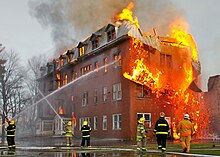Structure fire
This article includes a list of references, related reading, or external links, but its sources remain unclear because it lacks inline citations. (September 2013) |

A structure fire is a fire involving the structural components of various types of residential, commercial or industrial buildings, such as barn fires. Residential buildings range from single-family detached homes and townhouses to apartments and tower blocks, or various commercial buildings ranging from offices to shopping malls. This is in contrast to "room and contents" fires, chimney fires, vehicle fires, wildfires or other outdoor fires.
Structure fires typically have a similar response from the fire department that include engines, ladder trucks, rescue squads, chief officers, and an EMS unit, each of which will have specific initial assignments. The actual response and assignments will vary between fire departments.
It is not unusual for some fire departments to have a predetermined mobilization plan for when a fire incident is reported in certain structures in their area. This plan may include mobilizing the nearest aerial firefighting vehicle to a tower block, or a foam-carrying vehicle to structures known to contain certain hazardous chemicals.
Types (United States)
[edit]In the United States, according to NFPA, structures are divided into five construction types based on the severity of the fire hazard:
| Type I: Fire Resistive | Typically used in high-rises. The material comprising the structure is either inherently able to withstand significant exposure to fire (concrete), or in which a fire resistive covering is applied to steel structural members. |
| Type II: Non-combustible | Typically used in strip shopping center malls. Roofs are constructed out of steel rafters. |
| Type III: Ordinary construction | Brick and mortar walls, wood frame floors. City rowhouses are where this type of construction is most often found. |
| Type IV: Heavy timber | Often used in churches or other community-based buildings. |
| Type V: Wood frame | Typically used in recent construction of single-family dwellings, townhouses, garden apartments with four floors or less. |
- Remains of a structure fire on Cotton Avenue, Macon, Georgia, US. c. 1876
- A burned house
Causes of house fires
[edit]The examples and perspective in this section deal primarily with the United States and do not represent a worldwide view of the subject. (August 2012) |
In a recent study, conducted by American Survey CO, for the period of 2005–2010, the causes of house fires across America were as follows:
- Appliances and electrical (stoves, microwaves, toasters, radiators, various heating systems, small appliances) - approximately 47%
- Gas leaks - around 5-7%
- Open flames (candles, fireplaces) - approximately 32%
- Children playing with matches - Around 10%
- Spreading of fires from house to house - approximately 3%
See also
[edit]External links
[edit]- National Fire Protection Association (US)
- NFPA Research
- Haung, Kai. 2009. Population and Building Factors That Impact Residential Fire Rates in Large U.S. Cities. Applied Research Project. Texas State University. http://ecommons.txstate.edu/arp/287/ Archived 2012-03-08 at the Wayback Machine


 French
French Deutsch
Deutsch

